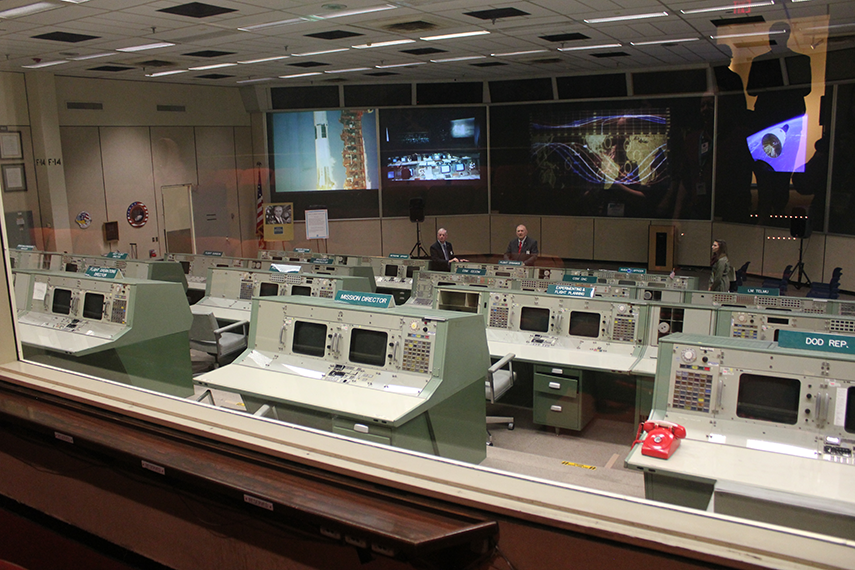Note: this lengthy post is about the preservation questions related to Historic Mission Control. I posted additional MOCR images to a gallery in November 2016.

The Mission Operations Control Room (MOCR) on the third floor of Building 30 at the Johnson Space Center in Houston is instantly recognizable and utterly awe-inspiring. Nearly every US citizen who was alive during the space race is familiar with the controller consoles and the large screens their operators looked up upon. Those who are too young to remember will likely recognize the room from history books or movies like Apollo 13.
MOCR was used for Project Gemini flights beginning with Gemini IV in 1965. The room was then reconfigured to meet the needs of Project Apollo beginning with Apollo 4 in November 1967. The room was reconfigured again for use with the Space Shuttle program beginning in 1976. In 1996, a similar mission operations control room on the second floor of Building 30 became the primary control room, presenting an opportunity for NASA to use the third-floor MOCR for interpretation of manned space flights in an improved visitor experience at Johnson Space Center.
Today, fundraising is underway to restore MOCR and the adjacent VIP, viewing, simulation, and projection rooms to the Apollo era. To many, this seems like a no-brainer; the work in the Apollo program is legendary. However, my recent trip to the iconic space facility raised more questions than I expected. Most prominently: by restoring MOCR to a narrowly defined portion of its period of significance (the Apollo era), is NASA limiting their ability to convey a broader, more authentic history of the US manned spacecraft missions?
Period of Significance
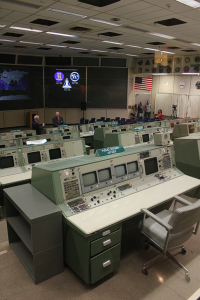
Federally recognized historic properties must have significance in history, architecture, archaeology, engineering, or culture. Significance is based on a property’s association with significant events and trends (National Register Criterion A), association with significant individuals (Criterion B), embodiment of significant design characteristics (Criterion C), or ability to yield significant information (Criterion C).
Once an area of significance is identified, the “period of significance” is a critical component for determining appropriate preservation treatments (i.e., how the property is conserved, interpreted, and used). The National Park Service describes period of significance as “the length of time when a property was associated with important events, activities, or persons, or attained the characteristics which qualify it for National Register listing.”
Properties can have multiple periods of significance, and those periods can be a single day or many decades. The period of significance (or a portion thereof) is typically chosen as the period to which a property is restored when it is turned into a museum venue, as contemplated at MOCR.
MOCR’s Period of Significance
The Apollo Mission Control Center was listed on the National Register of Historic Places and designated a National Historic Landmark on October 3, 1985, a component in the Man in Space Theme Study (which is also available for download at archive.org). Although the nomination calls out the achievements made culminating in the first successful moon landing in 1969, significance is tied to other US manned spacecraft programs, including Gemini, Apollo, Skylab, Apollo-Soyuz, and the Space Shuttle.
Significant dates are noted as “1965-present” on its designation, with “present” technically being 1984 when the nomination was completed. While National Historic Landmark designation of active facilities is not unusual, the inclusion of contemporary activity in the period of significance is rare and speaks to the importance of the facility’s use for all manned spacecraft missions rather than solely Apollo.
The Preservation Problem
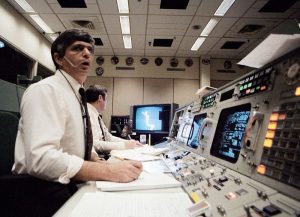
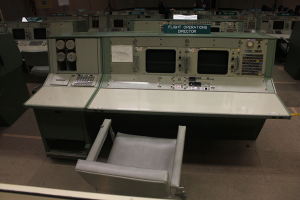 The console interpreted as the Flight Operations Director’s console today. (Image source: Barbara A.M. Howard, Stonebridge Learning LLC)
The console interpreted as the Flight Operations Director’s console today. (Image source: Barbara A.M. Howard, Stonebridge Learning LLC)
NASA wishes to not only preserve MOCR and its adjacent rooms but also to use the facility to tell the history of US manned spacecraft missions. The National Park Service’s “Historic Furnishings Report and Visitor Experience Plan: Apollo Mission Control Center National Historic Landmark” (2015) recommends restoring the rooms to their appearance during the Apollo era, specifically Apollo 11 through 17 (roughly 1969 – 1972). As a rare example of a federal agency actually fulfilling National Historic Preservation Act requirements to preserve their historic properties, this action should definitely be applauded.
However, I am struck not only by the room’s connection to Apollo but also by its connection to the Space Shuttle. I was in a junior high school art studio when Challenger broke apart in January 1986, taking the lives of five astronauts and two payload specialists (including the first civilian in space, teacher Christa McAuliffe). Images from that day are still burned into my memory.
Although the event postdates the facility’s National Historic Landmark designation by nearly four months, it is certainly an important point in MOCR’s timeline. It was the first time American astronauts were killed in flight and NASA grounded the Space Shuttle for nearly three years. If the facility were designated a National Historic Landmark today, I suspect the Space Shuttle program might be given more prominence in the nomination and the period of significance would extend to 1996, when activity moved to the second floor.
As part of NASA’s restoration plans, the room and the consoles will be restored to their Apollo-era design, eliminating features, controls, and configurations specifically used by the Space Shuttle.
The problem I see with the restoration is that it will erase layers of authentic history in order to bring the highest significance (the Apollo era) to the forefront. Tangible reminders of nearly a quarter century of the history of manned spacecraft missions will be gone. What becomes of recognizing, documenting, and commemorating the history of the Space Shuttle program, including that of prominent failures like Challenger? Are there other properties through which that story can be appropriately recognized? And what of Project Gemini and Skylab? Are their histories ignored so that the Apollo story can be told in an unblemished environment?
Layers of History Tell a Richer Story
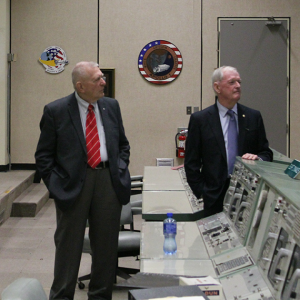
During my trip to MOCR, I met the great Glynn Lunney and Gene Kranz. Both men served as flight directors for Gemini and Apollo, and worked with NASA well into the Space Shuttle period. Today, they are gracious hosts on tours and talks bringing attention to the preservation needs at MOCR.
I walked away with a better understanding of the relationship mission control had with their crews and the utmost respect these two men had for the room in which we gathered. Their relationship with this historic place did not end with Apollo 17 or the designation of the facility in 1985. It continues today.
As we discuss the future of preservation, we need to reconsider how periods of significance are identified and used as part of preservation and interpretation efforts. National Register and Landmark nominations convey the significance of historic properties from the singular perspective (that of the writer) and at a single point in time (the date of completion). They cannot tell the whole history nor should they be considered a definitive script for preservation efforts.
For every person in our field who decries the yeoman’s effort needed to document National Register or Landmark eligibility there is someone lamenting the history left untold in the nominations accepted for listing. How can we as a field balance these needs, ensure historic properties are recognized for their layers of history, and tell a richer, authentic story for generations to come?

